
Neon Collapse is a hectic co-op space shooter where you and your friends fight against overwhelming odds to defend your mothership from certain destruction in a chaotic universe.
In Neon Collapse you and up to 3 of your friends pilot the last remaining fighter ships protecting the mothership.
As of 05/27/2018 Neon Collapse has earned $136.69 and received 193 downloads from its store page at https://moonraccoons.itch.io/neon-collapse.
Trailer




Weapons
Gameplay Goals:
-
Protect the mothership from endless waves of enemies.
-
Protect yourself and your friends from the enemies.
-
Survive as many waves as you can.
You can:
-
Move (twin stick).
-
Shoot your basic fire.
-
Use a secondary weapon.
-
Buy new secondary weapons.
-
Use a movement ability.
-
Buy new movement abilities.
-
Increase the universe size.
-
Repair the mothership.
For this project I:
Took up a leadership role of the lead Gameplay Designer. Along with that, I did a significant portion of the programming/visual scripting, some visual effects, and some cinematics.
As the lead, I was responsible for making sure my team of 2 designers and I completed tasks quickly and on time. While also ensuring I communicated with all other departments to provide them with the info they needed so they knew exactly what they needed to do and why.
-
Designed initial concept and continued to lead the design to the end.
-
Programmed many gameplay and UI elements.
-
Took ownership of all marketing and the business vision for the project.
-
Lead 80% of all meetings.
-
Ensured everyone from all roles had the information they needed in a timely fashion from whomever they needed it from.




Movement Abilities




Enemies


Mega Bosses
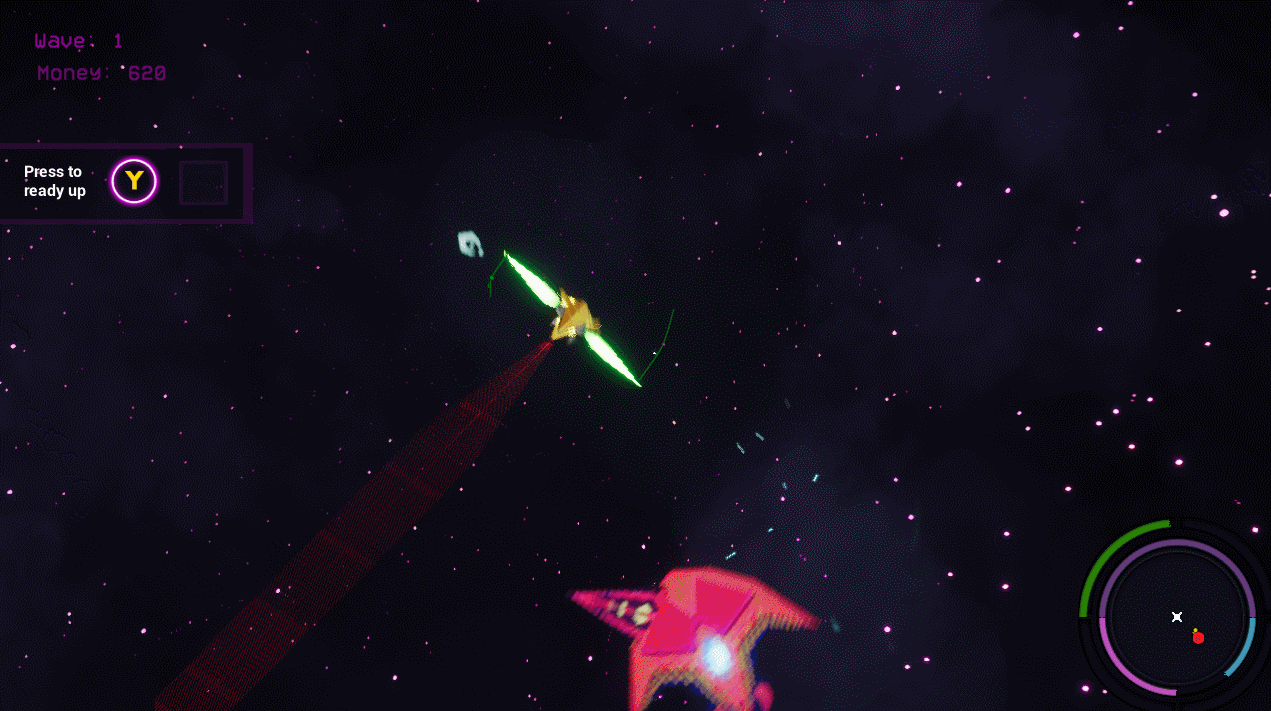
Pillars:
Comradery:
Neon Collapse is a Co-op game at its core. All weapons, abilities, and enemies should reward the player for using teamwork.
Enemy Hell:
Not just bullet hell. You will have bullets flying at you, giant enemies, teammates, and more; all physics enabled. Be careful with your movement but don't stay still either.
Explosive Combat:
Every break between waves should feel like a gift. The core combat should be fast and constantly keeping the player communicating and thinking as fast as they can.
Specific Design Elements:
Although a large portion of the design I did through group brainstorm sessions, there were some specific elements I had the chance to design on my own. If you are interested in how I lead these group design sessions please feel free to email me.
My Solo Designs:
Laser Swords
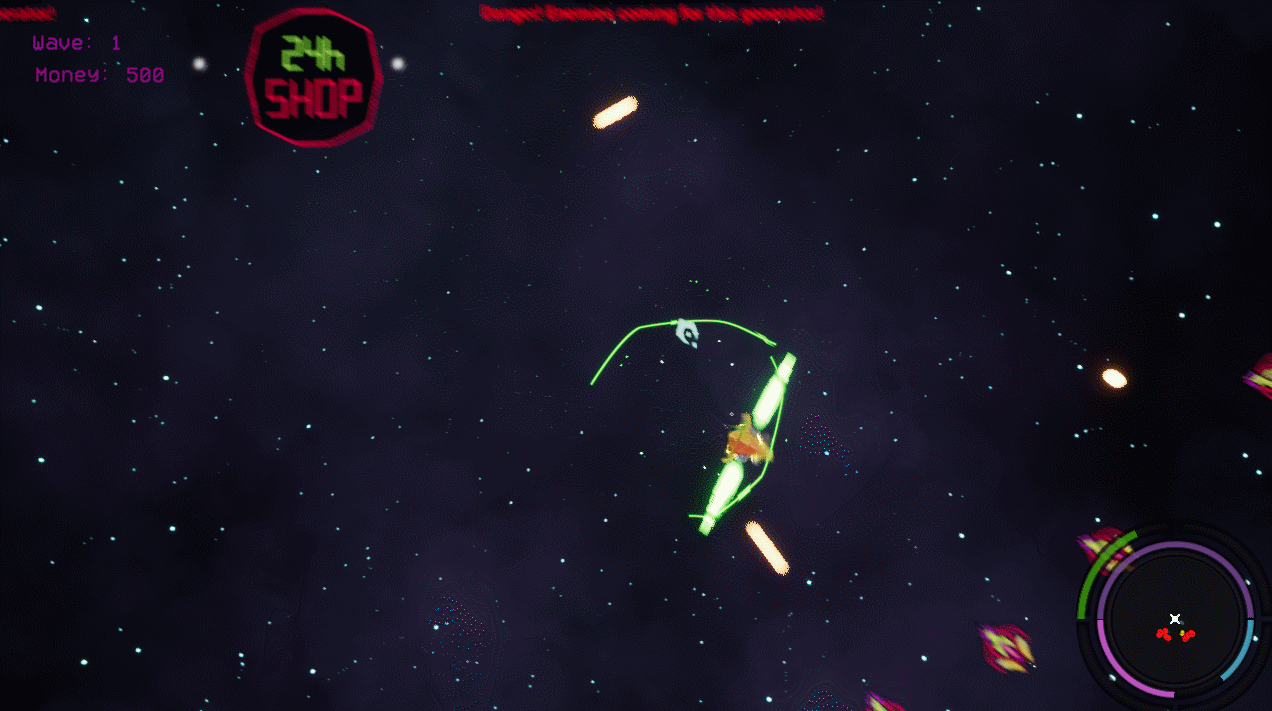

Laser Swords:
This was the first Secondary Weapon to be made.
To use them:
-
Hold right bumper to activate.
-
Deals overlap damage every 0.1 seconds.
-
The faster the player spins, the more damage done.
-
If a blade is shot, it will deflect a bullet and double its damage. (enemy or ally bullet).
Through playtesting/analytics they have been rated the most enjoyable weapon in the game.
Enemy Hell:
-
Designed to give the player a chance against the overwhelming numbers.
-
The swords are great for making quick work of basic enemies and can do incredible amounts of damage to bosses if you position yourself right.
-
High-risk, high-reward weapon, sacrifice distance and safety for damage.
Explosive Combat:
-
Nothing like flying into a group of enemies spinning your thumbstick as fast as possible while screaming at the top of your lungs, or at least that's what our players tell us.
-
Made to allow the player to get right in and personal when it comes to combat.
Comradery:
-
Deflecting a teammates bullet, overcharging it, and destroying an enemy creates a great moment.
Formation Boost
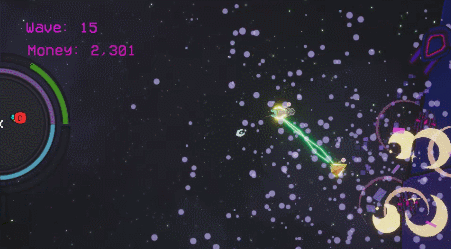
Formation Boost:
It links close players together giving them:
-
Increased healing rate.
-
Increased damage.
If the players go over X speed while still in formation the bonuses double.
Bonuses do not stack for more players together.
Enemy Hell:
-
It rewards moving quickly with more health and damage, but moving too fast makes it harder for you to predict and avoid the enemies around you.
Explosive Combat:
-
Allows players to survive longer and take more risks in battle. For example, someone with laser swords can now be a bit safer while flying into a group of enemies if they have a friend with them.
-
Increase player damage.
Comradery:
-
Creates moments of almost dead players yelling at their friends to come close to them.
-
Makes players communicate about their position.
-
Rewards players for working together.
-
Creates a fun dynamic of enemies trying to split you up while you try and stay together.
Paddle Guy:
Made to strike fear into any player. Also the first entry in our "Disrupter" enemy type.
-
Moves slower than a player.
-
Has two large damage dealing paddles to swack you around.
-
When below 30% health his speed quadruples.
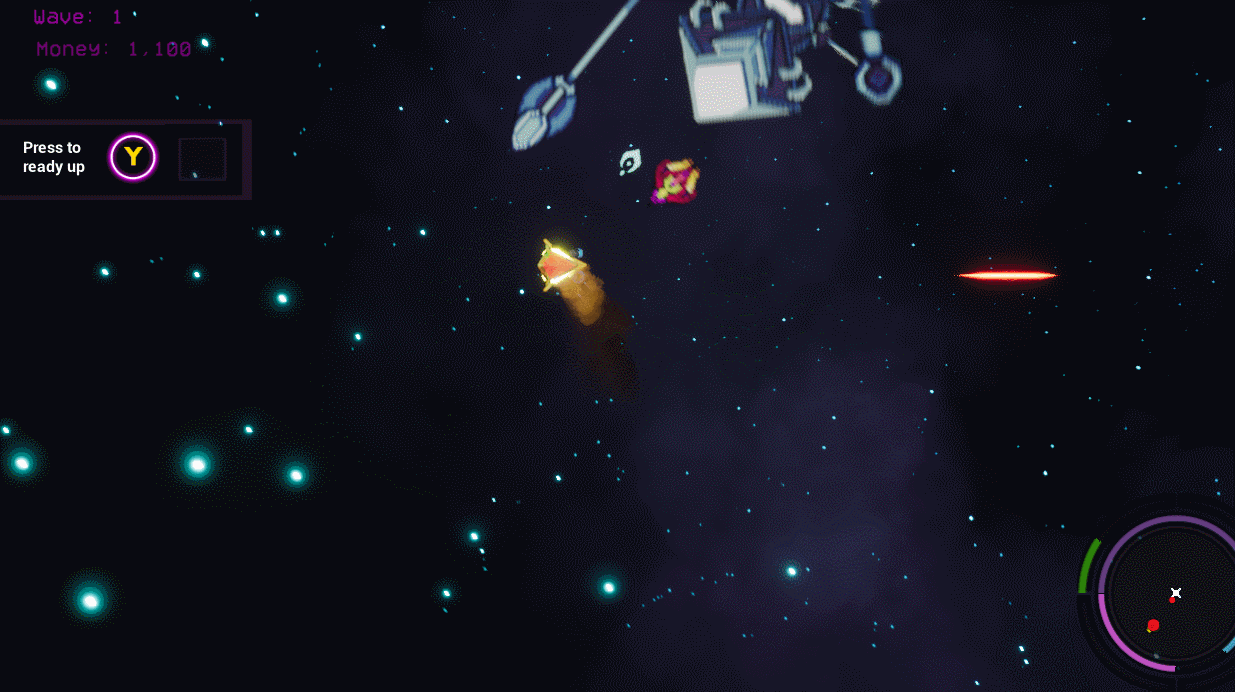
Paddle Guy
Enemy Hell:
-
He is the definition of enemy hell, where instead of just dodging bullets you are dodging super fast enemies 10x your size with two crazy long paddle arms.
Explosive Combat:
-
The panic he puts in players when they first discover his low health ability. He goes from "oh that's kinda cool but manageable" to " OH **** ".
Comradery:
-
With the formation boost being so important, being swacked away from your team can be fatal.
-
By balancing him so that he will almost always hit you before you kill him if you fight him solo, we make him a priority for players to kill as a team.
-
When one is spotted, players are calling for help and preparing to burst him down as soon as he goes berserk.
Scaly Boy
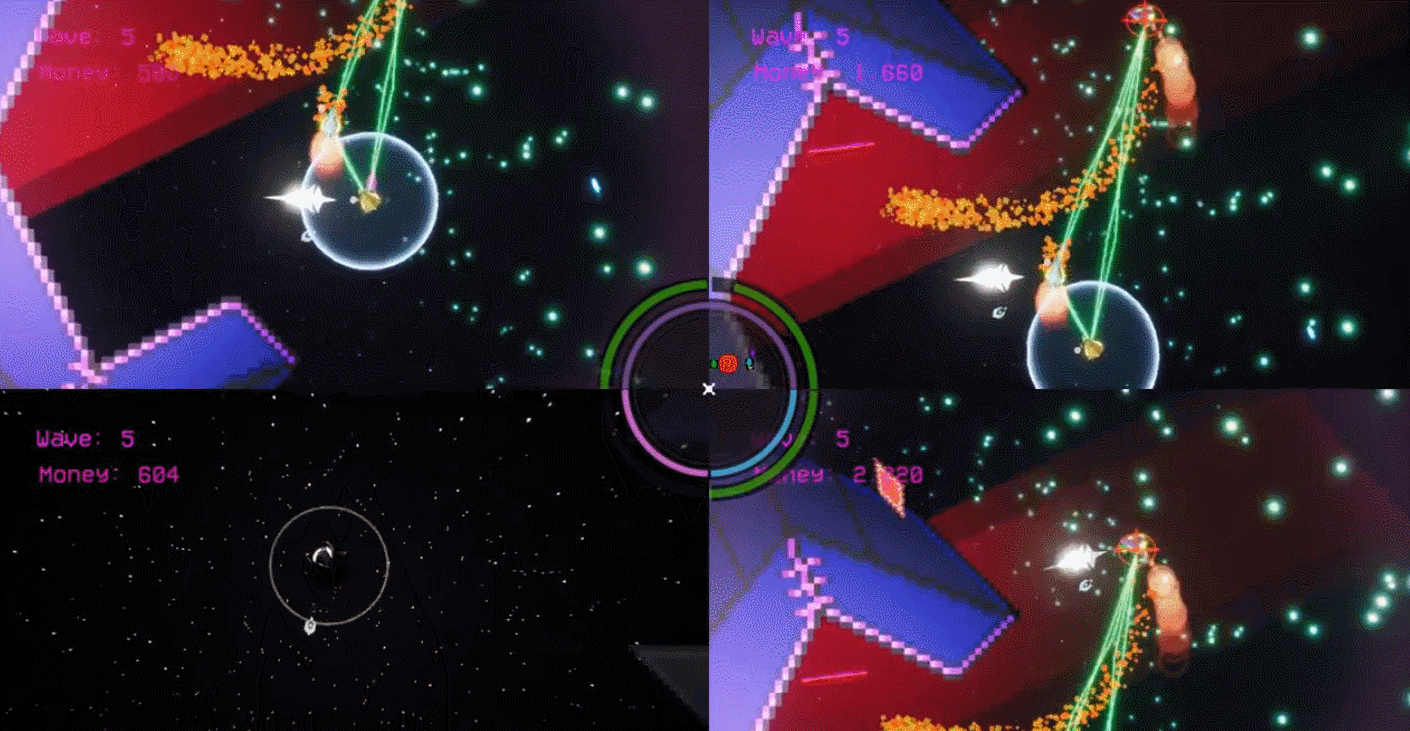
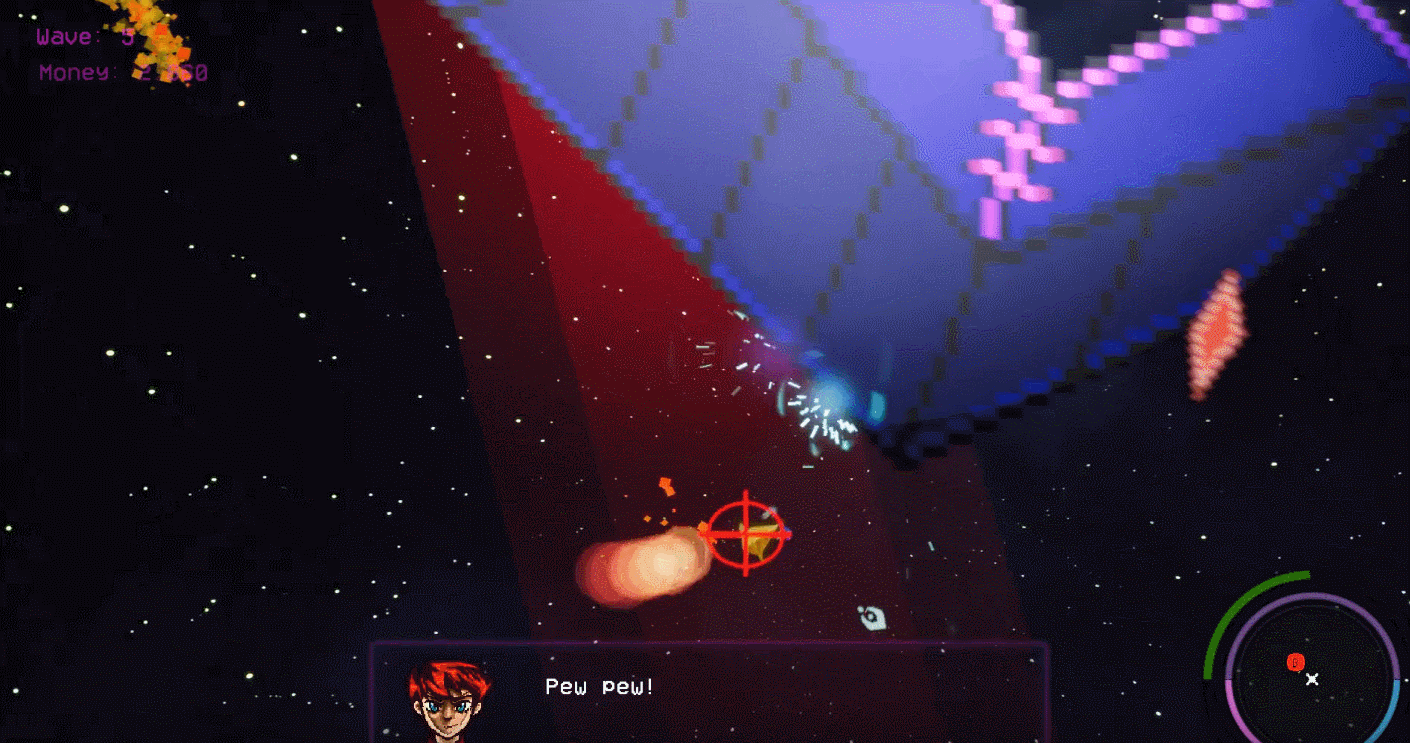
Scaly Boy:
Our first mega boss.
The goal of a mega boss is to change up the gameplay a bit. So instead of your objective being to protect the mothership, it would become something else.
In the case of Scaly Boy, the objective became to protect the target player.
Scaly Boy was designed to push the comradery pillar to the max.
He appears alone without any other enemies. Making sure the focus is now him.
-
He targets a player with his death cannon.
-
A red scale appears on his body somewhere at random. When the scale breaks a new one appears somewhere else.
-
Players have 8 seconds before Scaly Boy fires his cannon and the targeted player is in a lot of trouble.
-
If the players shoot the scale the targeted player gets 2 more seconds before the cannon fires.
-
If the players hit 4 scales, Scaly Boy takes 1 damage (out of 3 total health), his target is broken, and he goes into a 3 second rest period.
-
After 3 seconds he targets a new player at random and another new scale appears.
-
This time there is only 6 seconds before he fires.
-
After he takes another point of damage the fire delay becomes 4 seconds.
Enemy Hell:
-
While we still want these experiences to feel like they belong in the game, Scally Boy was mostly made to really push the comradery pillar and change the beat of the game slightly to prevent the normal gameplay from going stale.
-
Scaly Boy serves as a pace change from the constant enemy hell.
Explosive Combat:
-
Once his death beam fires, players are avoiding a sweeping beam chasing one of their friends, doing tons of damage to anyone in it.
Comradery:
-
The scales space out far enough along his body that you can not hit all the scales in time unless you work as a team and spread out. This creates a fun scenario of a targeted panicked player screaming at his friends to hurry up and save him.
-
His shape and size were made in a way that allowed for maximum communication for players. For example, there are many spots where you can see the scale on the other side of him, but for you to fly around and get it, it would take too long, so you must communicate and tell a teammate who may be closer to where it is.
-
His beam, once fired, was also greatly designed to push communication. It chases one player and sweeps across the map. This player needs to be sure to alert the other players of his movement otherwise he may drag the laser into a teammate killing them.
Enemy Hell:
-
With crazy amounts of enemies, it's easy to get lost while trying to find a dead player. This is why we added the dead player waypoint. This allows for players to focus on the combat while traversing toward their dead friend.
-
Trying to keep the panic in all players, physics was kept enabled on dead players. Meaning a dead player could be knocked around by anyone. This kept the gameplay moving for all players, even dead ones, who can't move on their own.
Explosive Combat:
-
Trying to grab a dead friend in the heaps of battle can be hard, this is one of the reasons we kept physics enabled on the dead player. This allows players to use their weapons and abilities to knock the dead player around into a better/safer position or just straight up into the mothership to be revived.
Comradery:
-
Needing another player to revive you gets communication going right away. Players die and call for help immediately.
-
By letting the dead players place walls to stop bullets and protect the player reviving them, we created some of the most joyful teamwork clutch situations we have ever seen. When there is only one player left alive, he has 1 hp, and the player on his back places a wall deflecting a would be fatal bullet, allowing the alive player to get the revive off and postponing the loss of the game for everyone.
-
Even in death, players need to work together.
-
With physics enabled on dead players, we require the dead player to keep other players informed of his position or soon to be position as he is flying through space after being swacked.

Revive
Revive:
Death needed to be punished but we didn't want it to take you completely out of the game.
A dead player can:
-
Rotate.
-
Drop walls.
When an alive player flies over a dead player the dead player will stick to their back. The alive player then needs to bring the dead player back to the mothership.
While a dead player is attached to an alive player they can still drop walls to block enemy fire.

